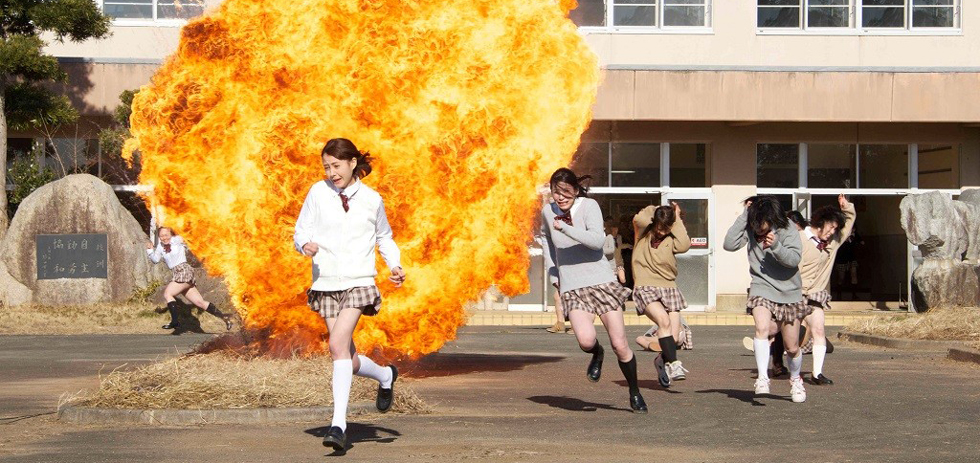
By the end of 2015, Sion Sono will have released six feature films this year. It’s one of the most frequently cited tidbits about the director in pieces discussing his more recent works, and it’s hard to deny that it’s an impressive feat – especially considering that none of the films Sono has released feel rushed, or more specifically, none of them feel like Sono would have done anything differently if he’d had longer to make them. That said, it’s easy to lose sight of why Sion Sono has become one of the most prominent and keenly watched directors working in Japan today. With Tag, we’re given a reminder of what has long distinguished the director from his contemporaries, and then some. It’s weird, tacky, imaginative, and crass, but Tag feels like a Sion Sono film in a way that many of the directors more recent works haven’t. It finds itself all over the place, treading the line between stylistic and disjointed, but that balancing act is Sono’s most lauded asset.
Tag is indebted to Yusuke Yamada’s Real Onigokko, which was published when the author was only 21 years old. Yamada’s novel imagines an alternate reality in dystopian Japan where people are being slaughtered by mysterious figures wielding machine guns. Things manifest a bit differently in Sono’s work, however, especially considering the fact that Real Onigokko was already adapted for film back in 2008. Sono’s script is his own, and the plot is fairly different from the novel – moreso a variation than clean-cut adaptation. Despite all of this, the 53-year-old director’s work is propelled by its playful sense of youth: hyper saturated with violence and packed with imaginative tangents, which make the fairly comparatively short work feel far denser than many of Sono’s recent ventures.
The opening scene of the film, wherein a gust of wind cuts two busloads of high school girls in half, gives the audience a fairly early indication that Tag is a spectacularly violent venture. Like any Sono work, it’s exaggerated and comically violent, but at the same time: hundreds of people are killed on screen and if you’re not familiar with the degree to which Japanese gore films can saturated themselves in blood (or don’t have any interest in finding out), it could be a smart idea to give this one a miss. It’s in these scenes, however, that Tag is able to establish such breadth in its tone and scope. One moment it’s a typical drama high school orientation scenes with Mistuko (initially Reina Triendl, with two other actresses also playing Mitsuko in the film) and her friends introducing themselves to one another, the next their entire class is being gunned down by the teacher because Mistuko skipped class. The editing of all of this throws in a perpetual sense of ambiguity as to the degree to which these scenes are grounded in reality at all. On the surface, the film teases the audience in these early scenes, presenting itself as a bit of a riff on the grindhouse formula. But it doesn’t stay there; with quick-cut movement and unpredictability at the heart of the work, enamoured with surreal scenes and editing reminiscent of Sono’s more abstract films.

Tonal inconsistency is often a phrase lobbed against films as a weakness; yet oddly, it’s one of Sono’s strongest characteristics – especially throughout Tag. It distinguishes the work from being a clichéd slasher, or a psychological thriller; and it sands back some of the rougher and cheaper elements of the film. There’s no shortage of sequences that are tacky, but in their intentionality, they give Tag a certain, much-needed self-awareness. At one point Mitsuko stares at the camera as feathers fall and says “life is surreal, don’t let it get to you… don’t let it consume you” as “Pure As Snow” from the post-rock band Mono plays, the saccharine nature of the scene is almost comedic.
Despite all of the hyper violence and fantasy that coats the film, Sono’s work is consistent in its subtle commentary throughout: the opening scene tackles the perception of mixed-race children in Japan, the constant allusions to Alice in Wonderland, and the framing of gender in the film. Like always, Sono treads a careful line between satire, criticism, and indulging in the subjects he targets. Though he displays a self-awareness and awareness of social criticism with regards to his sexualisation of female characters, his presentation is still likely to make viewers uncomfortable (whilst probably also giving more than a little discomfort to those who seek this hyper-sexualisation out). One noticeable shift in this vein from his recent Tokyo Tribe is in the centricity and importance of the film’s female characters. Where in Tokyo Tribe, the treatment of women was unsettling – with the director alienating the audience his film was commenting on the mistreatment of – Tag places them as the heroines that carry the work.
In the end, Sono’s film is lifted above the works of his contemporaries by the ambition and scope of his narratives and imagination. The distinguishing element of Sion Sono’s most memorable work is use of violence as a means rather than an end. Tag is ridiculously violent, but appears in random bursts throughout the playful and imaginative mess of narrative. By the end of it all, the drone shots (a relatively new addition to Sono’s films) feel a bit gimmicky and overdone, but they sit as one of the very scarce elements that grow stale in the film; Tag moves so fast that there isn’t much time for the audience’s minds to linger on the imperfections that punctuate it. Tag entertains without falling into cliché and is a stylish and succinct return to form for the director.
Around the Staff
| Felix Hubble | |
